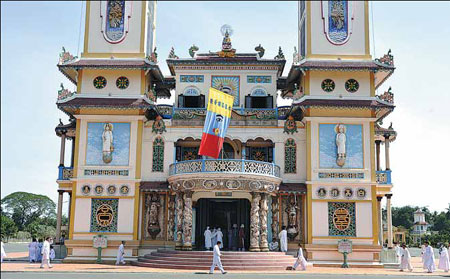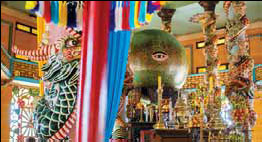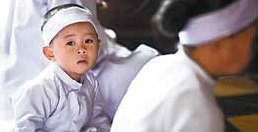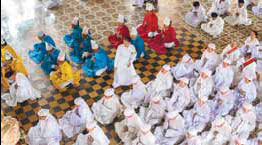Fusion of faiths
Updated: 2013-02-15 07:56
By Erik Nilsson (China Daily)
|
||||||||
|
Cao Dai's fusion of faiths is manifested most prominently in its Great Temple, which is frequented by not only devout followers but also by inquisitive visitors. Photos Provided to China Daily |
|
The Great Temple's structure is an assortment of symbolism from various creeds. |
Sun Yat-sen, Laozi and Buddha are venerated by most Chinese but worshiped by Vietnamese Cao Daists - along with Jesus, Mohammad, Pericles, Joan of Arc, Louis Pasteur, Vladimir Lenin, William Shakespeare and Victor Hugo. That's not to mention practitioners' ancestors. Cao Dai's fusion of faiths is manifested most prominently in its Great Temple, which is frequented by not only devout followers but also by inquisitive visitors. This building's structure, like that of the religion it houses, is also an assortment of symbolism from various creeds.
Seven-headed cobras personify the seven human emotions. The 28 dragon-coiled columns embody Buddha's 28 forms. The main dome's nine sections - spangled with stars - represent the nine parts of heaven.
But the icon that gives the greatest insight into Cao Dai's theology is the all-seeing left eye symbolizing both God and the heart.
The reason it's not the right eye can be seen in its pupil - a yin-yang symbol. In Cao Dai's assessment, God is yang, and yang is leftward.
The concept of yin and yang comes from Taoism, as does the name Cao Dai, which translates as "High Tower".
|
Cao Dai, translating as "High Tower", was formally founded in 1926. |
That's largely because its founder, Ngo Van Chieu, was Taoist until a table-juddering seance purportedly led him to embrace all gods as different manifestations of the human understanding of a supreme being.
The temple's color scheme also adheres to the theology's interfaith affinity. Yellow represents Buddhism, blue nods to Taoism and red signifies Christianity.
Cao Dai is an amalgam of Confucian morality, Taoist ritualism, Buddhist karma and reincarnation, and Roman Catholic hierarchy, and it even has its own pope. It also borrows components from other world faiths as well as the Vietnamese Giniists.
While it recognizes all major religions' deities, it considers them one god understood in different ways, ultimately making it monotheistic.
As the religion's official website puts it: "The noble effort of Cao Dai is to unite all of humanity through a common vision of the Supreme Being, whatever our minor differences, in order to promote peace and understanding throughout the world.
"Cao Dai does not seek to create a grey world, where all religions are exactly the same, only to create a more tolerant world, where all can see each other as sisters and brothers from a common divine source, reaching out to a common divine destiny realizing peace within and without."
Cao Dai's relatively young age might explain its post-modern theology. It was formally founded in 1926, and the Great Temple - one of about 1,000 in southern Vietnam - was constructed in Tay Ninh city from 1933 to 1955.
|
Worship is staged every six hours, starting at midnight. |
Visitors can watch services in the 5,200-square-meter temple from the balcony as long as they're quiet, shed their shoes and don trousers. Worship is staged every six hours, starting at midnight.
While clergy are clad in colorful robes according to their primary theological gravitations - Buddhists wear yellow, for instance - rank-and-file believers appear in white. Bishops and cardinals are designated by pyramidal headpieces adorned with the Divine Eye.
Worshipers assemble in rows to sing Western-style hymns over traditional Vietnamese instrumentation.
Men kneel on the right and women on the left. Although Cao Dai proclaims the sexes equal, women can't ascend to the two top tiers of the clergy because it would upset the balance of yin, which embodies the feminine, and yang, which is masculine.
The waves of worshipers flood a space that largely resembles a Catholic cathedral in layout, with two square towers, a rectangular nave, an altar, an apse and an ambulatory positioned as in most churches.
Still, the construction is crowned with a mosque-like dome and a pagoda, while the eaves crawl with dragons, lest the structure seem too basilican. Totally unlike the place of worship for any other major religion, a giant globe emblazoned with the Divine Eye occupies the altar in the temple.
Perhaps because of its uniqueness, adherents are said to have been persecuted from the time of communist victory until Cao Dai's 1985 legalization.
Most outsiders consider the temple and the doctrine to which it's dedicated a novel curiosity.
But a visit enables non-believers to wonder at the global multiplicity of deities, the belief in which ultimately makes humans human.
Contact the writer at erik_nilsson@chinadaily.com.cn.
(China Daily 02/15/2013 page10)

 In Photos: 7.0-magnitude quake hits Sichuan
In Photos: 7.0-magnitude quake hits Sichuan
 Li Na on Time cover, makes influential 100 list
Li Na on Time cover, makes influential 100 list
 FBI releases photos of 2 Boston bombings suspects
FBI releases photos of 2 Boston bombings suspects
 World's wackiest hairstyles
World's wackiest hairstyles
 Sandstorms strike Northwest China
Sandstorms strike Northwest China
 Never-seen photos of Madonna on display
Never-seen photos of Madonna on display
 H7N9 outbreak linked to waterfowl migration
H7N9 outbreak linked to waterfowl migration
 Dozens feared dead in Texas plant blast
Dozens feared dead in Texas plant blast
Most Viewed
Editor's Picks

|

|

|

|

|

|
Today's Top News
Live report: 7.0-magnitude quake hits Sichuan, heavy casualties feared
Boston suspect cornered on boat
Cross-talk artist helps to spread the word
'Green' awareness levels drop in Beijing
Palace Museum spruces up
First couple on Time's list of most influential
H7N9 flu transmission studied
Trading channels 'need to broaden'
US Weekly

|

|











